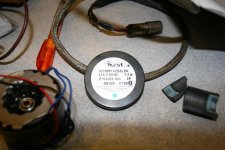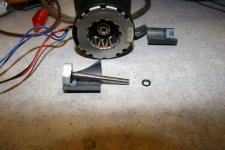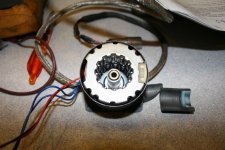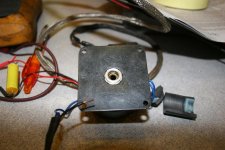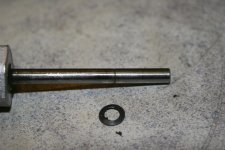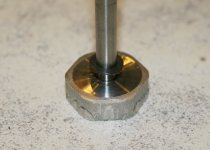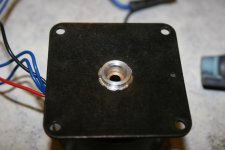Here's some images of the "cracked" Hurst motor. Interesting....
The motor shaft is supported only on one end by a single bronze bushing. My rough estimate is 1" (25mm) long. IMHO this long bushing supports the shaft well since it covers most of the length of the shaft and with the magnet on one end and the driven end at the other end it might be plenty of support. I would also assume that the bronze bushing is fine with proper lubrication. As long as it doesn't dry out, it should be fine and it would appear that too much lubricant would not be much of a problem as there are no brushes etc. in the motor to care. It might be an interesting experiment to fill up the motor with lubricant and see how it runs.???? We could call it hydo dynamic phase dampening or some such audiophile nonsense.
The shaft is retained in the motor by a one way washer, or spring washer. You can see in the image that the shaft has a groove machined into it to hold the washer. It is very difficult to remove the washer. We just hammered the shaft out of the motor which broke the magnet. The washer itself is not accessible since it sits down into a pocket or shoulder in bushing assembly so the only way to remove it is to destroy it, IMHO.
The retaining washer is the source of the audible noise that I have heard and others have reported about these motors. The washer will work as a thrust bearing on the end of bronze bushing and or rub against the inside of the bushing retainer pocket. I'm not sure how big a problem this really is.
Overall I'm impressed with the construction of the motor for what it is. The bushing arrangement is nicer than I expected, notwithstanding the thrust washer. I think the most obvious idea for improvement might be to improve the thrust washer design. For audio I would think the strong steel clip could be replaced by plastic or other material to retain the shaft for thrust.
I am also interested in the RA series of motors which have a larger shaft and the option for bushings or ball bearings and single ended to two ended shafts. Stefano has mentioned that he prefers smaller, lower torque, 24 V motors, but the larger motors might have better bushings or provide easier "hot rodding" of the bushings. If the perfect sine wave and phase generators improve the small motors, maybe they would solve the issue of the larger motor noise and cogging? enabling the use of quieter shafts and bushings.
Or, there is nothing wrong with these nice little motors??
Jamie
The motor shaft is supported only on one end by a single bronze bushing. My rough estimate is 1" (25mm) long. IMHO this long bushing supports the shaft well since it covers most of the length of the shaft and with the magnet on one end and the driven end at the other end it might be plenty of support. I would also assume that the bronze bushing is fine with proper lubrication. As long as it doesn't dry out, it should be fine and it would appear that too much lubricant would not be much of a problem as there are no brushes etc. in the motor to care. It might be an interesting experiment to fill up the motor with lubricant and see how it runs.???? We could call it hydo dynamic phase dampening or some such audiophile nonsense.
The shaft is retained in the motor by a one way washer, or spring washer. You can see in the image that the shaft has a groove machined into it to hold the washer. It is very difficult to remove the washer. We just hammered the shaft out of the motor which broke the magnet. The washer itself is not accessible since it sits down into a pocket or shoulder in bushing assembly so the only way to remove it is to destroy it, IMHO.
The retaining washer is the source of the audible noise that I have heard and others have reported about these motors. The washer will work as a thrust bearing on the end of bronze bushing and or rub against the inside of the bushing retainer pocket. I'm not sure how big a problem this really is.
Overall I'm impressed with the construction of the motor for what it is. The bushing arrangement is nicer than I expected, notwithstanding the thrust washer. I think the most obvious idea for improvement might be to improve the thrust washer design. For audio I would think the strong steel clip could be replaced by plastic or other material to retain the shaft for thrust.
I am also interested in the RA series of motors which have a larger shaft and the option for bushings or ball bearings and single ended to two ended shafts. Stefano has mentioned that he prefers smaller, lower torque, 24 V motors, but the larger motors might have better bushings or provide easier "hot rodding" of the bushings. If the perfect sine wave and phase generators improve the small motors, maybe they would solve the issue of the larger motor noise and cogging? enabling the use of quieter shafts and bushings.
Or, there is nothing wrong with these nice little motors??
Jamie
Attachments
Pyramid,
I hope you don't live where it's warm year round because I we'll miss you if you're on the golf course.
I've just read back through your posts on speed control and it was like an epiphany. I have to say epiphany as it is really more like brilliant ideas of others going into my head.
I've been struggling with the idea of speed control for months. Not knowing how to measure, what to measure, how to implement, why simple solutions won't work, etc.
Now I believe that with your precision tach concept for speed control, which must occur over a longer cycle, at least 1 rev as I believe you explained very well and I am also a bit mystified as to why it was not better received, and then using mass for short term speed control. sq225917's FFT methods should be able to measure the result of the mass and mechanical speed control. I don't know why these two methods would not be able to measure all of the audible influence of speed???
In any case, I am going to PM you to see what more can be done. Thank you for the explanations, my thinking is greatly improved by your sharing of knowledge.
Cheers,
Jamie
I hope you don't live where it's warm year round because I we'll miss you if you're on the golf course.
I've just read back through your posts on speed control and it was like an epiphany. I have to say epiphany as it is really more like brilliant ideas of others going into my head.
I've been struggling with the idea of speed control for months. Not knowing how to measure, what to measure, how to implement, why simple solutions won't work, etc.
Now I believe that with your precision tach concept for speed control, which must occur over a longer cycle, at least 1 rev as I believe you explained very well and I am also a bit mystified as to why it was not better received, and then using mass for short term speed control. sq225917's FFT methods should be able to measure the result of the mass and mechanical speed control. I don't know why these two methods would not be able to measure all of the audible influence of speed???
In any case, I am going to PM you to see what more can be done. Thank you for the explanations, my thinking is greatly improved by your sharing of knowledge.
Cheers,
Jamie
Arch,
Good question. I took a closer look at the retaining washer and the opposite end thrust washers and they both appear to be non-metallic. I can't tell what material. Maybe plastic. They are graphite in color.
I don't understand now why it is so hard to get the retaining washer to slip out of it's groove when removing the shaft, but metal circlip retainers have amazing pull out strength.
So, right side up and bottom side up running should be similiar in terms of the washer materials running against the ends of the bronze bushing, but in the case of bottom side up the washer has backing support by the end magnet plug and a bit looser fit around the shaft.
Right side up running would appear to have a lubrication advantage though.
Jamie
Jamie
Good question. I took a closer look at the retaining washer and the opposite end thrust washers and they both appear to be non-metallic. I can't tell what material. Maybe plastic. They are graphite in color.
I don't understand now why it is so hard to get the retaining washer to slip out of it's groove when removing the shaft, but metal circlip retainers have amazing pull out strength.
So, right side up and bottom side up running should be similiar in terms of the washer materials running against the ends of the bronze bushing, but in the case of bottom side up the washer has backing support by the end magnet plug and a bit looser fit around the shaft.
Right side up running would appear to have a lubrication advantage though.
Jamie
Jamie
Attachments
I had read about the noise issue in a forum, and I noticed it the first time I plugged in the VPI SAMA right of the box. But it went away with a tap and might just go away after running in for a while. I'm not sure it's really an issue and like with most things if we fuss over them enough we'll find something.
It was more instructive for me to see as DIY that I would have access to the same motors that some very well respected mfg's would have. To be perfectly fair though the exact part number used by VPI is not to be found on the Hurst website. I doubt the construction is much different, but there might be some special VPI sauce in the motor.
For now I am going to assume the motor is perfectly fine and that there are other more significant issues with getting a respectable diy table going.
But, I will keep in mind some potential solutions for the motor now that I understand it's construction better. Sometimes, the devil you know......
Cheers,
Jamie
It was more instructive for me to see as DIY that I would have access to the same motors that some very well respected mfg's would have. To be perfectly fair though the exact part number used by VPI is not to be found on the Hurst website. I doubt the construction is much different, but there might be some special VPI sauce in the motor.
For now I am going to assume the motor is perfectly fine and that there are other more significant issues with getting a respectable diy table going.
But, I will keep in mind some potential solutions for the motor now that I understand it's construction better. Sometimes, the devil you know......
Cheers,
Jamie
Maybe it is possible to support the pulley by some Teflon part to avoid a pressure on the washer.
Hey sq225917,
Which Igus bearing did you try? Igus offers 30 different materials, of course it's a bit hard to know what they are since they use model numbers, but it's not too hard to guess based on properties. For example I'm sure some are teflon, glass reinforced teflon, nylon, etc. Just looking in McMaster Carr there are dozens of different bushing materials of the same configuration but you couldn't know the mfg. for repeatability.
I want to use a Pierre Lurne configuration so it makes it hard to keep metallic bearings lubricated as they are upside down.
The plastic bushings don't reach close tolerances to the shaft until after they are pressed in place. I was suspecting this might need to be tuned for each bearing and material. Do you think the bearings were noisy due to tolerancing? What kind of noise? Do they stick/slip?
Did you find the cause of the noise? What worked better?
Cheers,
Jamie
Which Igus bearing did you try? Igus offers 30 different materials, of course it's a bit hard to know what they are since they use model numbers, but it's not too hard to guess based on properties. For example I'm sure some are teflon, glass reinforced teflon, nylon, etc. Just looking in McMaster Carr there are dozens of different bushing materials of the same configuration but you couldn't know the mfg. for repeatability.
I want to use a Pierre Lurne configuration so it makes it hard to keep metallic bearings lubricated as they are upside down.
The plastic bushings don't reach close tolerances to the shaft until after they are pressed in place. I was suspecting this might need to be tuned for each bearing and material. Do you think the bearings were noisy due to tolerancing? What kind of noise? Do they stick/slip?
Did you find the cause of the noise? What worked better?
Cheers,
Jamie
Arch,
The spacing between the two washers is fairly tight. The retaining washer is held by the machined groove and the other washer against the magnet plug. So, It's a bit difficult to change the arrangement.
Again though, I'm not sure there's really a problem considering both washers appear to be a plastic or friction reducing material. Could even be graphite impregnated. Since it's relatively difficult to disassemble, re-assemble, etc., I would tend to think that there's a good chance of doing worse than the factory assembly and a lot of work to do something better. IMHO.
Jamie
The spacing between the two washers is fairly tight. The retaining washer is held by the machined groove and the other washer against the magnet plug. So, It's a bit difficult to change the arrangement.
Again though, I'm not sure there's really a problem considering both washers appear to be a plastic or friction reducing material. Could even be graphite impregnated. Since it's relatively difficult to disassemble, re-assemble, etc., I would tend to think that there's a good chance of doing worse than the factory assembly and a lot of work to do something better. IMHO.
Jamie
I mean, without removing anything on the motor, it is possible to slide a fork (made of Teflon) between the top side of the motor and the bottom side of the pulley, to support the pulley.
By trimming the height of the fork you can suppress all pressures on the washers.
But you are right it is perhaps not worth while.
Obviously in that case the motor is running right side up.
By trimming the height of the fork you can suppress all pressures on the washers.
But you are right it is perhaps not worth while.
Obviously in that case the motor is running right side up.
Last edited:
Sq225917, I forgot to ask about Hylon. Why is the deformation a bad thing? Using something like a 3/8" Silicon Nitride ball as a thrust bearing wouldn't it be a good thing to have the ball "seat" into the Hylon?
The point of contact with the ball will be some kind of spherical dimple regardless of hardness, just relatively larger or smaller depending on Mod E. The rotational drag shouldn't change for a given coefficient of friction since the surface area and pressure would offsett each other as the thrust ball seats in.
I'm assuming the point of contact is wobbly anyway as the concentricity won't be perfect. The Hylon is about as hard (brinnel or Mod E should predict about same), but the coefficient of friction is greatly reduced, at least in published numbers.
If the hardness is an issue I'd rather not try to solve with glass fibers as they do not address hardness and have a counterproductive influence on coefficient of friction for point loads.
Were you able to measure problems with softer thrust plate materials? Your FFT methods should be a great way to find bearing noise, unless it's intermittant.
Jamie
The point of contact with the ball will be some kind of spherical dimple regardless of hardness, just relatively larger or smaller depending on Mod E. The rotational drag shouldn't change for a given coefficient of friction since the surface area and pressure would offsett each other as the thrust ball seats in.
I'm assuming the point of contact is wobbly anyway as the concentricity won't be perfect. The Hylon is about as hard (brinnel or Mod E should predict about same), but the coefficient of friction is greatly reduced, at least in published numbers.
If the hardness is an issue I'd rather not try to solve with glass fibers as they do not address hardness and have a counterproductive influence on coefficient of friction for point loads.
Were you able to measure problems with softer thrust plate materials? Your FFT methods should be a great way to find bearing noise, unless it's intermittant.
Jamie
Arch,
The top side washer sits down in a pocket so it's hard to get to. For shimming with a fork or dis-assembly. I think it would be possible to turn down the top of the bearing sleeve retaining cylinder making it easy to get to the top washer either for removal or easier resetting of the washer when noise occurs. Of course this little pocket also makes it easier to drop oil into the sleeve.
Jamie
The top side washer sits down in a pocket so it's hard to get to. For shimming with a fork or dis-assembly. I think it would be possible to turn down the top of the bearing sleeve retaining cylinder making it easy to get to the top washer either for removal or easier resetting of the washer when noise occurs. Of course this little pocket also makes it easier to drop oil into the sleeve.
Jamie
Attachments
Turntable PSU and tach
No, I live behind the cheddar curtain (Green Bay WI ) it's currently below zero, which means I have to use the green golf balls this time of year.😀
) it's currently below zero, which means I have to use the green golf balls this time of year.😀
That's where all of this started; I bought a MH Cruise Control, wasn't happy with it, so started out to roll my own PSU. I looked for a way to measure the results but could not find anything other than strobes, so before I built the PSU, I came up with the tach. One of the comments I hear most often is:"Why does it need that level of accuracy?", which totaly blows me away; I didn't think test equipment could be "too" accurate. The PSU ignores the 3rd decimal digit (impractical to control it to that level with a belt drive) and it's doubtful whether anyone can hear a .01RPM error, but if you don't correct it, the errors accumulate and within 10-15 minutes, the speed is off by 0.2 RPM which is definitely audible (especially if you correct then).
Thanks for the positive feedback.....
Pyramid,
I hope you don't live where it's warm year round because I we'll miss you if you're on the golf course.
No, I live behind the cheddar curtain (Green Bay WI
 ) it's currently below zero, which means I have to use the green golf balls this time of year.😀
) it's currently below zero, which means I have to use the green golf balls this time of year.😀 I've been struggling with the idea of speed control for months. Not knowing how to measure, what to measure, how to implement, why simple solutions won't work, etc.
That's where all of this started; I bought a MH Cruise Control, wasn't happy with it, so started out to roll my own PSU. I looked for a way to measure the results but could not find anything other than strobes, so before I built the PSU, I came up with the tach. One of the comments I hear most often is:"Why does it need that level of accuracy?", which totaly blows me away; I didn't think test equipment could be "too" accurate. The PSU ignores the 3rd decimal digit (impractical to control it to that level with a belt drive) and it's doubtful whether anyone can hear a .01RPM error, but if you don't correct it, the errors accumulate and within 10-15 minutes, the speed is off by 0.2 RPM which is definitely audible (especially if you correct then).
Thanks for the positive feedback.....
No, I live behind the cheddar curtain (Green Bay WI) it's currently below zero, which means I have to use the green golf balls this time of year.😀
-9F here in Waukesha....woooo....it's flipping cold in WI!!!!

Regarding the tach, I don't find it misleading at all. A measurement instrument is never too precise...am I greedy? 😀
Arch,
The top side washer sits down in a pocket so it's hard to get to. For shimming with a fork or dis-assembly. I think it would be possible to turn down the top of the bearing sleeve retaining cylinder making it easy to get to the top washer either for removal or easier resetting of the washer when noise occurs. Of course this little pocket also makes it easier to drop oil into the sleeve.
Jamie
Is the washer that makes the noise I hear? How did you remove the shaft? Is the washer that holds the shaft in place? If so, is that maybe something that can be improved?
Or do I need to disassembled the motor more to get to other parts?
-9F here in Waukesha....woooo....it's flipping cold in WI!!!!
I saw a squirrel raiding my bird feeder this morning...I'm guessing his nuts were frozen.

I believe it is the washer that makes the noise, but the washer is non-metallic. So, it could be caused by the longitudinal play of the shaft oscillating back and forth. I would need to play with a running motor now that I've broken one to see inside. I could also put it back together and look for longitudinal play in the shaft. I'll try that and report back.
- Home
- Source & Line
- Analogue Source
- Motor for turntable
